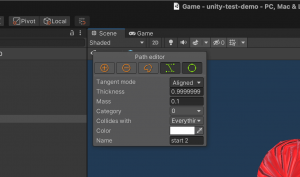rope pass through video link to make sure we on the same page
As the title suggest, i'm trying to make the effect of numbers of ropes nested with each other with Obi Rope version 6.2. At first, the ropes have no collisions between each other at all, i solved it by reading the FAQ by setting the collides with attribute to everything for all the control points in my rope.

But then i discover the rope is too easily pass through each other after the collisions happened, by reading the doc, this seems is a feature. When move the ropes in the unity scene mode, rope first collide then the inner particles seems tear apart (i suspect).

I don't want this behaviour, so i try following method which none of them solve my problem.
As the title suggest, i'm trying to make the effect of numbers of ropes nested with each other with Obi Rope version 6.2. At first, the ropes have no collisions between each other at all, i solved it by reading the FAQ by setting the collides with attribute to everything for all the control points in my rope.
But then i discover the rope is too easily pass through each other after the collisions happened, by reading the doc, this seems is a feature. When move the ropes in the unity scene mode, rope first collide then the inner particles seems tear apart (i suspect).
I don't want this behaviour, so i try following method which none of them solve my problem.
- set the mass of the control point to a larger value
- add more pooled particles in the rope blueprint
- tweak the constraints setting (collisions and distance)in the obi solver by make evaluation to parallel and set the iteration to 20 instead of 1
- change the collision material to some package provided one




